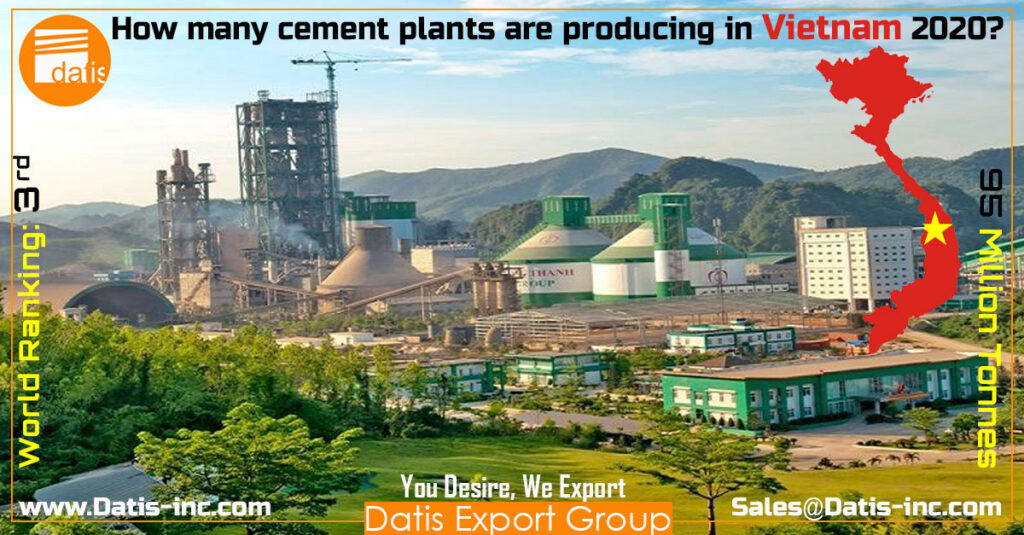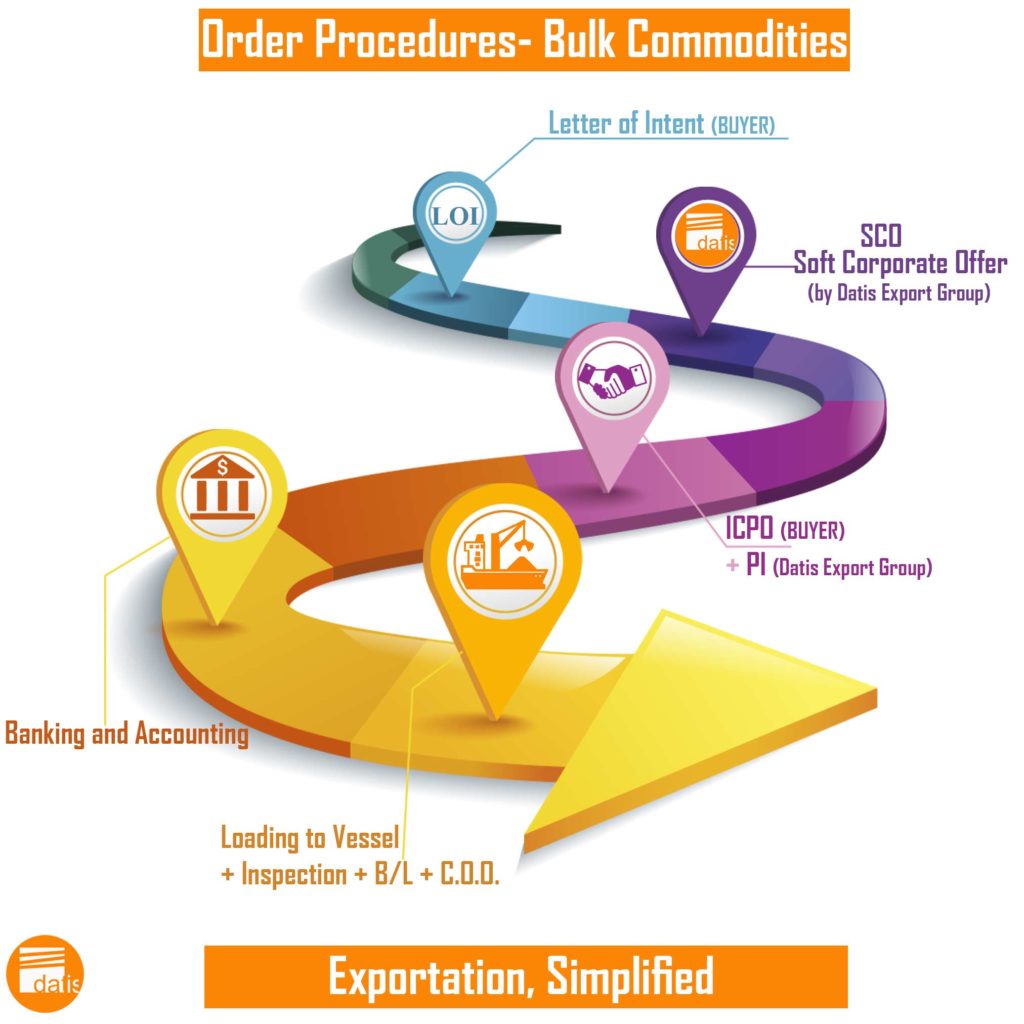How many cement plants are producing in Vietnam 2020?
History and Development of Portland Cement in Vietnam
In 1975 the war ended with the fall of Saigon, the center of the southern war effort now known as Ho Chi Minh City. Since 1976 the country has operated as a single-party socialist republic with the communist party in control of the executive, legislative and judicial branches of government. The country has steadily developed diplomatic relationships with most countries, including the US in 1995. The country has been developed rapidly, although it started from a low base after three decades of conflict and remains the least developed in Indonesia, Malaysia and Vietnam.
Economy
Since 1976, Vietnam has had to recover from the terrible damage inflicted on it by two successive wars. To begin with, its communist regime was backed by the USSR as it had been in the Vietnam War, with the country receiving many billions of dollars worth of military funding and food aid until the dissolution of the USSR in 1989.
The extent of the Vietnamese economy’s reliance on this source of revenue can be seen in the GDP/capita graph. The country’s GDP/capita rate fell to below US$100 in 1989 and 1990 and only recovered above US$200 in 1994.
Immediately before the collapse of the USSR, Vietnam had begun a transition from a centrally-planned economy to a socialism-based market economy. This has seen a shift towards exports like crude oil and rice, as well as manufactured products like clothes, shoes, electronics, machinery and wood products. Its customers are primarily the US (18%), China (11%), Japan (11%) and Germany (4%).
Vietnam brings in processed petroleum products, vehicles, steel products, raw materials for the clothing and shoe industries, plastics and various electronic items. Despite the fact that Vietnam’s exports were up by 33% year-on-year in 2011, the country imports more than it exports. This has brought about a trade deficit that is adversely affecting other parts of the economy. High inflation, estimated at over 18% (average) in 2011 means that the Vietnamese Dong is on a downward trend and has been gradually devalued by 20% since 2008.
With the economic woes of some of its major export partners set to continue for the foreseeable future, the Vietnamese economy is likely to continue to suffer more in the coming months and years.
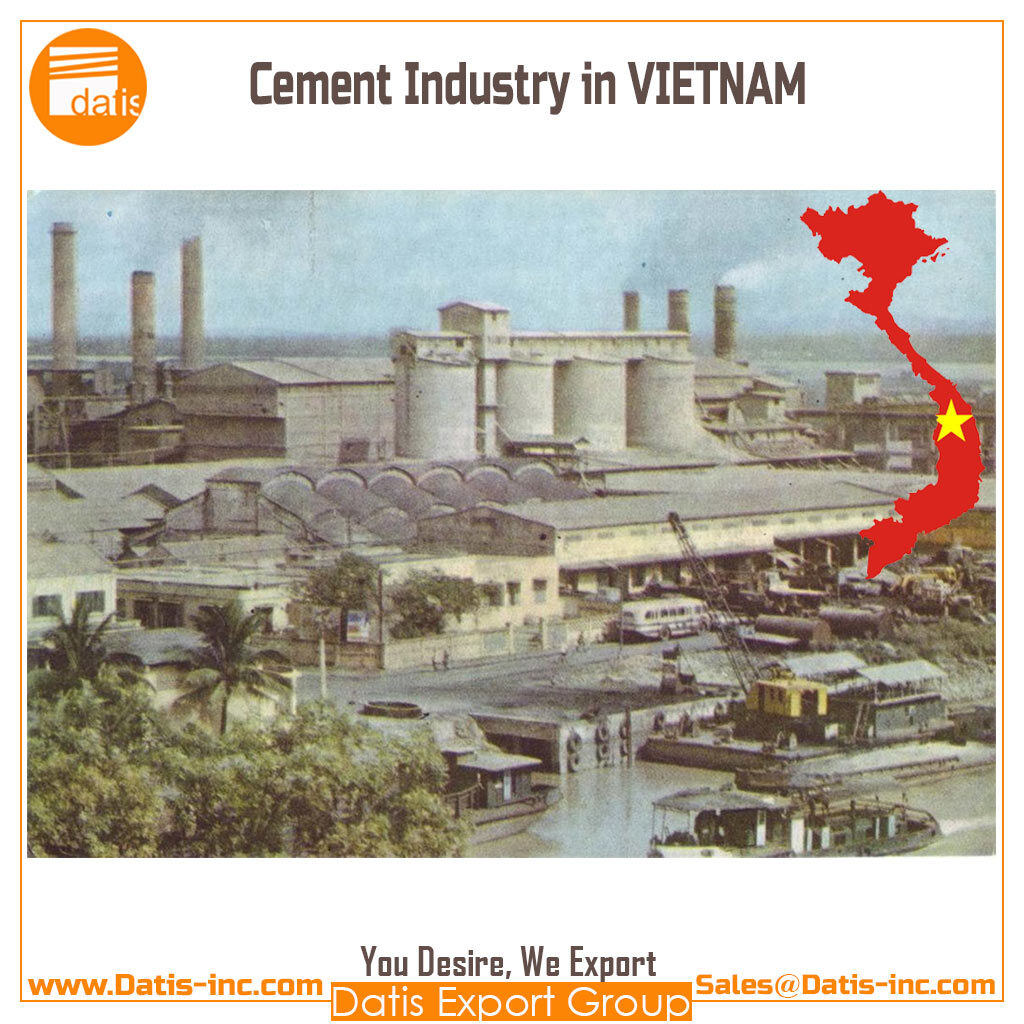
Vietnam Cement Industry-Introduction
A headline figure of 71.3Mt/yr according to the Global Cement Directory 2012, (which includes a number of forthcoming plant projects and upgrades), places its cement industry as high as eighth largest in the world after China, India, Russia, the US, Russia, Japan, and South Korea.
In 2012 the US Geological Survey reported that Vietnam had a clinker capacity of closer to 55Mt/yr in both 2010 and 2011. It reported that cement production was in the region of 50Mt/yr, placing it in the company of countries such as Indonesia, Brazil and Saudi Arabia. These headline figures indicate a capacity utilization rate of approximately 85%, assuming clinker to cement ratio of 0.95.
The Vietnam National Cement Association (VNCA) represents the interests of the industry and affiliated smaller companies and research centers.
Vietnam Cement Industry- Corporations and companies
Much of the Vietnamese cement industry is overseen by VICEM, the Vietnamese Cement Industry Corporation, which directs much of the largely state-run industry. Positioned somewhere in the middle of three roles; trade association, a government unit, and cement producer, VICEM has control over production levels at the majority of Vietnam’s cement plants, including many Joint-Stock Companies and the Vietnamese plants of multinational firms.
1) VICEM:
Previously known as the Vietnam National Cement Corporation (VNCC), VICEM is Vietnam’s major established cement manufacturer. It operates 12 plants in Vietnam. Its oldest plants are Ha Tien 1 (1964), Bim Son (1980), and Hoang Thach (1980). Additional capacity was subsequently added at Hai Van (1994) But Son (1997), Hoang Mai (2000), and Hai Phong.
2) Joint Stock Companies:
A number of Joint-Stock Companies (JSC) operate in the Vietnamese cement market. Although this type of cement company has operated in the market since the 1960s (Phu Tho 1967, Chieng Sinh 1973, Thai Binh 1979), a new wave came online in the 1990s due to the gradual transition from central planning to a socialist-based market economy.
These include Chinfon Cement Corporation (1992), Song Da (1994), Phuc Son (1996), Viet Trung (1996), Kien Khe (1996) and Quang Ninh (1998).
3) Foreign firms:
The Nghi Son Cement Corporation, a JSC established in 1995, saw the start of foreign involvement in the Vietnamese cement market with Japanese cement firm Taiheiyo and fellow Japanese company Mitsubishi.
The Swiss multinational cement giant Holcim has been involved in the Vietnamese market since 1994, when it set up Morning Star Cement as a joint-venture with VNCC. Now called Holcim Vietnam (since 2002) and split between Holcim and VICEM, the company’s production site is in Hon Chong in the extreme south of the country. The 2Mt/yr site, which includes an integrated plant, limestone quarry, clay quarry, a sea port and a river port for barges, covers a total area of 5.6km2. Holcim Vietnam also operates a grinding facility at Thi Vai, in the central south of the country. Approximately 70km east of Ho Chi Minh City, the plant grinds up to 1.4Mt/yr of cement on the banks of the Thi Vai River. The operation also has five ready-mix concrete batching plants in and around Ho Chi Minh City. It has 1500 employees across its cement and concrete operations.
France’s Lafarge also has an interest in the country, setting up a liaison office and concrete plant in 2003.
The first cement plants in Vietnam
VICEM Cement Company
Previously known as the Vietnam National Cement Corporation (VNCC), VICEM is Vietnam’s major established cement manufacturer. It operates 19 plants in Vietnam.
Its oldest plants are:
- Ha Tien 1 (1964),
- Bim Son (1980)
- Hoang Thach (1980).
Additional capacity was subsequently added at Hai Van (1994) But Son (1997), Hoang Mai (2000) and Hai Phong.
Hai Phong Cement Factory
Hai Phong Cement Factory was established in 1899, again by the French, as the first cement factory with four rotary kilns in Indochina. The portland cement factory exclusively exploited materials to produce cement, which was a totally new construction component in Vietnam at that time.
With the well-known red dragon and blue dragon label, Hai Phong Cement showed up at the Liege expo (France) in 1904, and thousands of tons were sold to other countries including Indochina, Java (Indonesia), South China and Singapore.
When the war ended in Vietnam, the factory also went through historical reforms. In 1986, the company was merged with Vietnam Cement Industry Corporation. Hai Phong Cement faced severe hardships and challenges due to obsolete equipment, lack of competitiveness and environmental pollution.
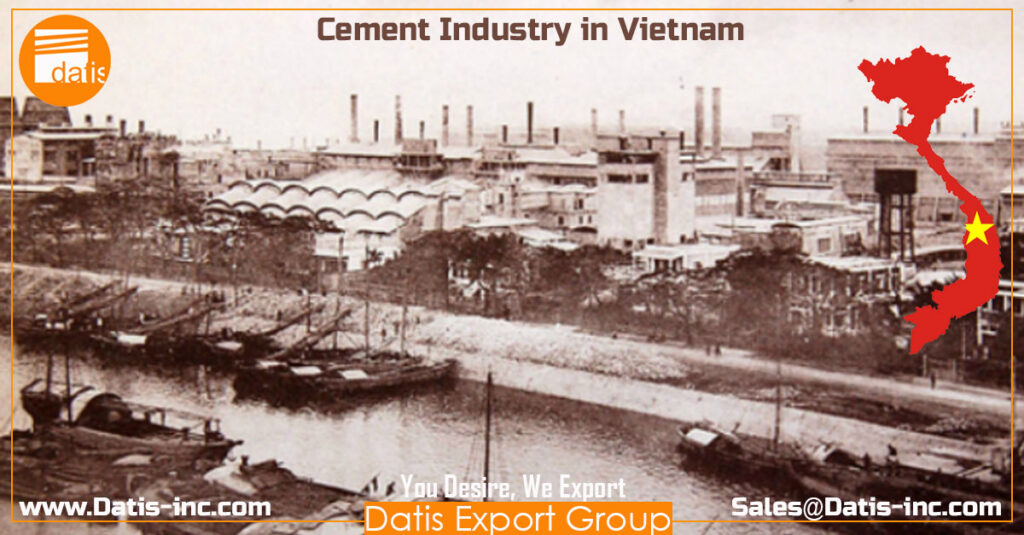
Vietnam Introduction
The most easterly of the countries on the Indochina Peninsula, the Socialist Republic of Vietnam stretches for over 1400km north to south. It shares borders with China to the north, Laos to the west and Cambodia in the southwest.
The country’s 91.5 million inhabitants make it the 13th most populous nation in the world, although its large area (331,210km2) means that it is far from overcrowded.
The main population centers are in the north east, surrounding the capital Hanoi and in the extreme south around Ho Chi Minh City, formerly known as Saigon. Additionally, the extensive eastern coast, which runs for over 3200km, is populated throughout its length, with population density generally decreasing as one goes inland.
VIETNAM | |
GDP (2011 est.) | US$104bn |
GDP/capita (Est.) | US$1184 |
Population (2012 est.) | 91.5m |
Area | 331,210 km2 |
Integrated cement plants | 51 |
Integrated capacity | 71Mt/yr |
Average plant capacity | 1.4Mt/yr |
- Summary data for Vietnam and its cement industry.
- Source: GDP from World Bank Indicator; Cement data from Global Cement Directory 2012.

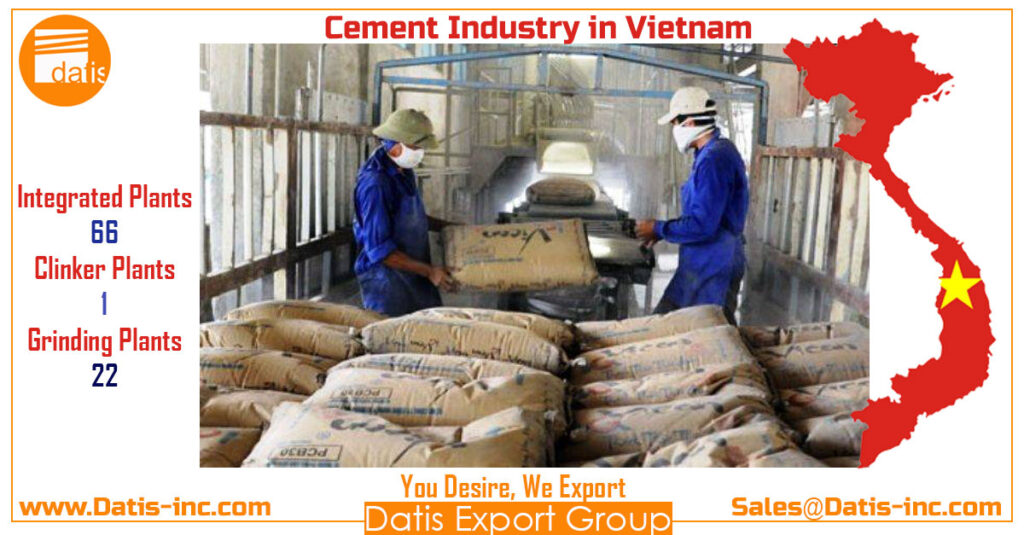
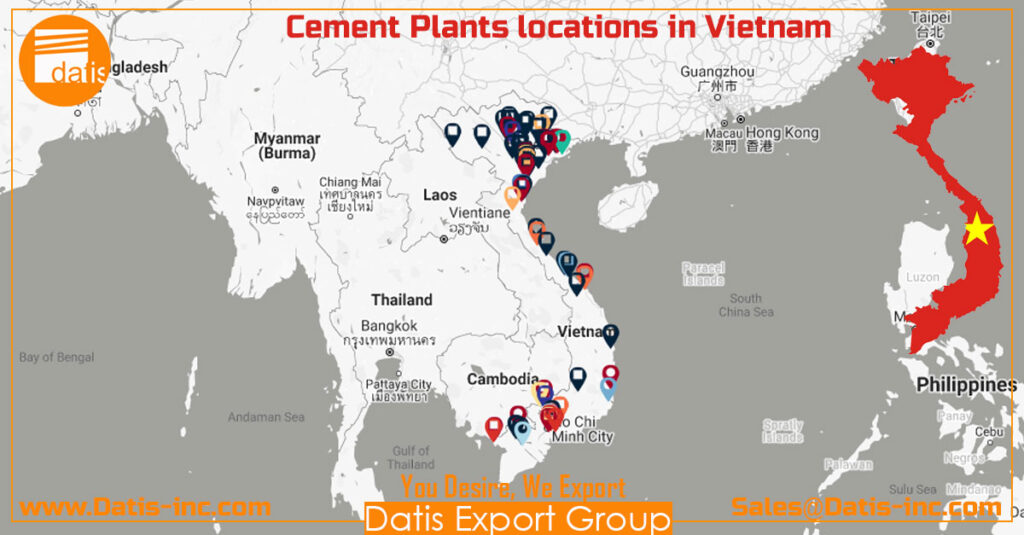
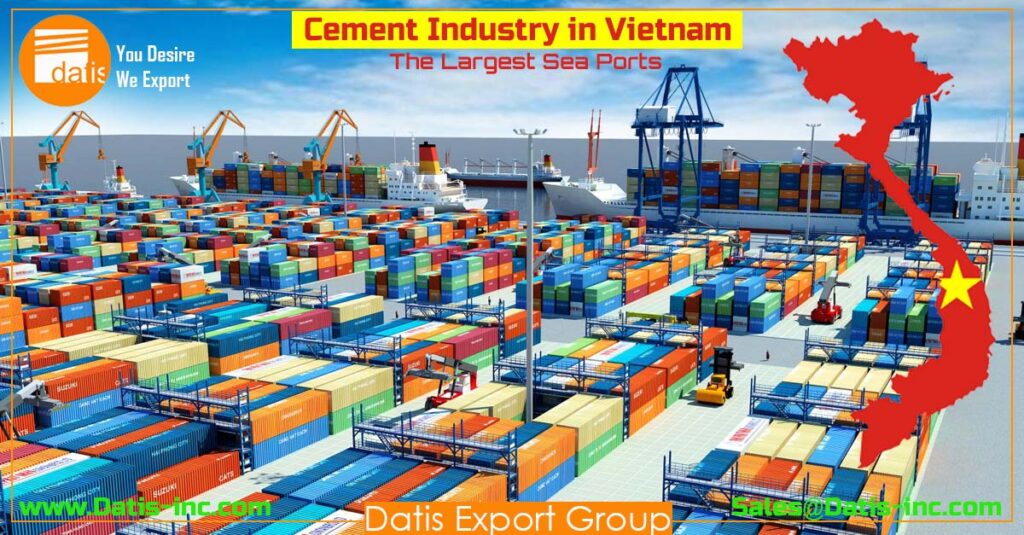
Cement Plants located in Vietnam
- Integrated Plants: 66
- Clinker Plants: 1
- Grinding Plants: 22
No | Group Name | Company Name | Facility Name | City |
1 | JSC Bicem | JSC Bicem | Binh Dinh CONSTREXIM | Tuy Phuoc |
2 | An Giang Cement Company | An Giang Cement Company | My Thanh | Long Xuyen |
3 | Ang Son Export Import & Production JSC | Ang Son Export Import & Production JSC | Ang son | Vạn Ninh |
4 | Bac Giang Cement JSC | Bac Giang Cement JSC | Huong Son | |
5 | BMT FiCO | BMT FiCO | BMT White | Bien Hoa City |
6 | Building Materials Corporation No 1 (FICO) | Building Materials Corporation No 1 (FICO) | Hiep Phuoc | Ho Chi Minh City |
7 | Building Materials Corporation No 1 (FICO) | Building Materials Corporation No 1 (FICO) | Tay Ninh FiCO | Tan Chau |
8 | Building Materials Corporation No 1 (FICO) | Building Materials Corporation No 1 (FICO) | Tay Ninh Grinding | |
9 | Cam Pha Cement JSC | Cam Pha Cement JSC | Cam Pha | Cam Pha City |
10 | Cam Pha Cement JSC | Cam Pha Cement JSC | Cam Pha Grinding | Cam Pha |
11 | Can Tho Mineral and Cement JSC | Can Tho Mineral and Cement JSC | Can Tho | Can Tho |
12 | Can Tho Mineral and Cement JSC | Can Tho Mineral and Cement JSC | Phu Huu | Phu Huu |
13 | Cao Ngan Cement Company | Cao Ngan Cement Company | Cao Ngan | |
14 | Cong Thanh Group | Cong Thanh Cement Company | Cong Thanh | Nhon Trach District |
15 | Cong Thanh Group | Cong Thanh Cement Company | Tan Truong | Tinh Gia |
16 | DIC Investment and Trading JSC | DIC Investment and Trading JSC | DIC Binh Phuoc Cement | Binh Phuoc |
17 | DIC Investment and Trading JSC | Huu Nghi J.S.C. | Huu Nghi | Viet Tri |
18 | Dien Bien Cement Joint Stock Company | Dien Bien Cement Joint Stock Company | Sam Mun | Dien Bien |
19 | Dong Lam Cement | Dong Lam Cement | Dong Lam | Phong Dien |
20 | Duyen Ha Cement | Duyen Ha Cement | Duyen Ha | Hoa Lu |
21 | Hoa Binh Cement Company | Hoa Binh Cement Company | Hoa Binh | Hoa Binh |
22 | Hoang Long Cement | Hoang Long Cement | Hoang Long | Ha Nam |
23 | Hoang Long Cement | Hoang Long Cement | Nam Son | Ha Noi |
24 | Kien Khe JSC | Kien Khe JSC | Kien Khe | |
25 | La Hien Cement JSC | La Hien Cement JSC | La Hien | |
26 | Lang Son Cement JSC | Lang Son Cement JSC | Lang Son | Lang Son |
27 | Long Son Cement | Long Son Cement | Long Son | Bim Son Town |
28 | Long Tho JSC | Long Tho JSC | Thuy Bieu | Hue City |
29 | Lucky Cement Co | He Duong Cement JSC | He Duong | |
30 | Lucky Cement Co | Phuc Son Cement Company | Phuc Son | Phuc Son |
31 | Luks Group (Vietnam Holdings) Company Limited | Luks Cement (Vietnam) Limited | Cong Hai | |
32 | Luks Group (Vietnam Holdings) Company Limited | Luks Cement (Vietnam) Limited | Luksvasi | Huong Tra |
33 | Mai Son Cement Co. Ltd. | Mai Son Cement Co. Ltd. | Mai Son | Son La |
34 | Phu Tan Co. Ltd. | Phu Tan Co. Ltd. | Phu Tan | Kinh Môn |
35 | Phu Tho Cement Co.,Ltd | Phu Tho Cement Co.,Ltd | Phu Tho | Ba Thanh Town |
36 | POMIHOA Group | Huong Duong JSC | Huong Duong | Tam Diep |
37 | Quan Trieu Cement – VVMI | Quan Trieu Cement – VVMI | Quan Trieu | |
38 | Quang Ninh Construction & Cement Co.,LTD | Quang Ninh Construction & Cement Co.,LTD | Lam Thach | |
39 | Quang Son Cement Company | Quang Son Cement Company | Quang Son | |
40 | Sai Son JSC | Sai Son JSC | Sai Son | |
41 | SCG Cement – Building Materials Co. Ltd | SCG Cement – Building Materials Co. Ltd | Dong Nai (White) | Dong Nai |
42 | SCG Cement – Building Materials Co. Ltd | SCG Cement – Building Materials Co. Ltd | Dong Nai (Grey) | Dong Nai |
43 | SCG Cement – Building Materials Co. Ltd | Vietnam Construction Materials JSC (VCM) | Song Gianh | Tuyên Hóa |
44 | SCG Cement – Building Materials Co. Ltd | Vietnam Construction Materials JSC (VCM) | Van Hoa | Da Nang |
45 | Semen Indonesia Group | Thang Long Cement JSC | Hiep Phuoc – Ho Chi Min | Ho Chi Minh City |
46 | Semen Indonesia Group | Thang Long Cement JSC | Thang Long | Quang Ninh |
47 | Siam City Cement, PLC (SCCC) Group | Siam City Cement (Vietnam) Ltd | Cat Lai | Ho Chi Minh City |
48 | Siam City Cement, PLC (SCCC) Group | Siam City Cement (Vietnam) Ltd | Hiep Phuoc | Hồ Chí Minh city |
49 | Siam City Cement, PLC (SCCC) Group | Siam City Cement (Vietnam) Ltd | Hon Chong | Hon Chong |
50 | Siam City Cement, PLC (SCCC) Group | Siam City Cement (Vietnam) Ltd | Nhon Trach | Nhon Trach |
51 | Siam City Cement, PLC (SCCC) Group | Siam City Cement (Vietnam) Ltd | Thi Vai | Phu My |
52 | STARCEMT Building Material Co. | STARCEMT Building Material Co. | Tuyen Hoa | Xuan Ha |
53 | Taiheiyo Cement Corporation | Nghi Son Cement Corporation (NSCC) | Hai Thuong | Nghi Son |
54 | Tan Quang Cement JSC | Tan Quang Cement JSC | Tan Quang | Tuyen Quang |
55 | Tay Do Cement JSC | Tay Do Cement JSC | Tay Do Grinding | Can Tho |
56 | Thai Binh Cement JSC | Thai Binh Cement JSC | Thai Binh | Thai Binh |
57 | ThaiGroup JSC | ThaiGroup JSC | Thanh My | Thanh My |
58 | ThaiGroup JSC | ThaiGroup JSC | Xuan Thanh | Thanh Nghị |
59 | Thanh Cong Company Ltd | Thanh Cong Company Ltd | Thanh Cong III Cement Plant Ltd | Kinh Mon |
60 | Thanh Thang Cement | Thanh Thang Cement | Thanh Thang | Thanh Liem district |
61 | Trung Son Cement | Trung Son Cement | Trung Son | Luong Son |
62 | Tuyen Quang Cement J.S.C. | Tuyen Quang Cement J.S.C. | Tuyen Quang | Tuyen Quang |
63 | Vietnam Cement Industry Corporation (VICEM) | Bim Son Cement JSC | Bim Son | Bim Son |
64 | Vietnam Cement Industry Corporation (VICEM) | But Son Cement JSC | But Son | |
65 | Vietnam Cement Industry Corporation (VICEM) | ChinFon Cement Corporation | Chin Fon | Hai Phong |
66 | Vietnam Cement Industry Corporation (VICEM) | ChinFon Cement Corporation | Haiphong White | Haiphong |
67 | Vietnam Cement Industry Corporation (VICEM) | ChinFon Cement Corporation | Hiep Phuoc | Ho Chi Minh City |
68 | Vietnam Cement Industry Corporation (VICEM) | Ha Long Cement Company | Ha Long | |
69 | Vietnam Cement Industry Corporation (VICEM) | Ha Long Cement Company | Ha Long Grinding | Hoanh Bo |
70 | Vietnam Cement Industry Corporation (VICEM) | Ha Long Cement Company | Hiep Phuoc | Ho Chi Minh City |
71 | Vietnam Cement Industry Corporation (VICEM) | Hai Phong Cement Company | Hai Phong | Hai Phong |
72 | Vietnam Cement Industry Corporation (VICEM) | Hai Van Cement JSC | Hai Van | Da Nang |
73 | Vietnam Cement Industry Corporation (VICEM) | Hoang Mai Cement JSC | Hoang Mai | Hoang Mai |
74 | Vietnam Cement Industry Corporation (VICEM) | Hoang Thach Cement Company | Hoang Thach | |
75 | Vietnam Cement Industry Corporation (VICEM) | Song Thao JSC | Ninh Dan | |
76 | Vietnam Cement Industry Corporation (VICEM) | Tam Diep Cement Company | Tam Diep | |
77 | Vietnam Cement Industry Corporation (VICEM) | Vicem Ha Tien Joint Stock Company | Binh Phuoc Cement Factory | Binh Long Town |
78 | Vietnam Cement Industry Corporation (VICEM) | Vicem Ha Tien Joint Stock Company | Cam Ranh | Cam Ranh |
79 | Vietnam Cement Industry Corporation (VICEM) | Vicem Ha Tien Joint Stock Company | Ha Tien / Kien Luong Cement Factory | Kien Luong |
80 | Vietnam Cement Industry Corporation (VICEM) | Vicem Ha Tien Joint Stock Company | Long An | Long An |
81 | Vietnam Cement Industry Corporation (VICEM) | Vicem Ha Tien Joint Stock Company | Phu Huu | Ho Chi Minh |
82 | Vissai Group | Dong Banh Cement JSC | Dong Banh | Lang Son |
83 | Vissai Group | Sông Lam 2 Cement JSC | Sông Lam (Du Luong) | Đô Lương District |
84 | Vissai Group | Vissai Cement | Ninh Binh | Ninh Binh Province |
85 | Vissai Group | Vissai Ha Nam JSC | Ha Nam | Ha Nam |
86 | X18 Cement JSC | X18 Cement JSC | X18 | |
87 | X77 Company | X77 Company | X77 | Ha Nam |
88 | Yen Bai Cement and Minerals J.S.C. | Yen Bai Cement and Minerals J.S.C. | Yen Bai | Yen Binh |
89 | Yen Binh Cement J.S.C. | Yen Binh Cement J.S.C. | Yen Binh | Yen Binh |

The Largest Cement producer in Vietnam
VICEM
19 Cement Plants/Cement Capacities
Previously known as the Vietnam National Cement Corporation (VNCC), VICEM is Vietnam’s major established cement manufacturer. It operates 19 plants in Vietnam. Its oldest plants are Ha Tien 1 (1964), Bim Son (1980) and Hoang Thach (1980).
The Vietnam National Cement Corporation (VICEM) has reported that Vietnamese producers exported 13.6Mt of cement between 1 January 2020 and 31 May 2020, down by 1.4% year-on-year from 13.8Mt in the corresponding five months of 2019. Producers exported 7.07Mt of cement to China, up by 26% from 9.55Mt, 2.08Mt to the Philippines, down by 29% from 2.93Mt, and 1.36Mt to Bangladesh, down by 9.9% from 1.51Mt. The total value of exported cement fell by 14% to US$505m from US$590m.
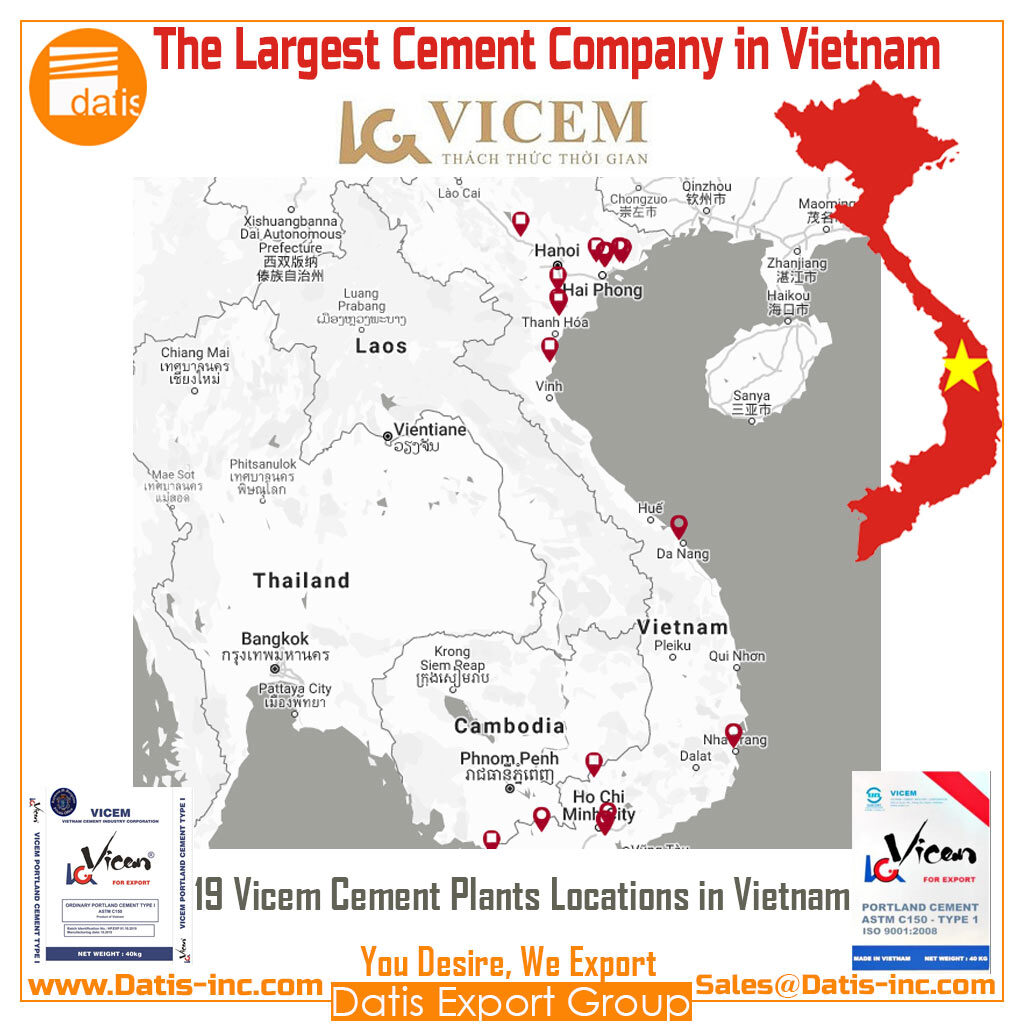
FLSmidth and VICEM will jointly work towards sustainable cement production in Vietnam
The Vietnam National Cement Corporation (VICEM), the leading cement producer in Vietnam, and FLSmidth, a global leader in sustainable technology, today announced a cooperation to pioneer new solutions to significantly improve the sustainability of the cement sector in Vietnam. The goal is to implement technologies that radically reduce greenhouse gas emissions, pioneer solutions for using alternative fuels and improve air quality.
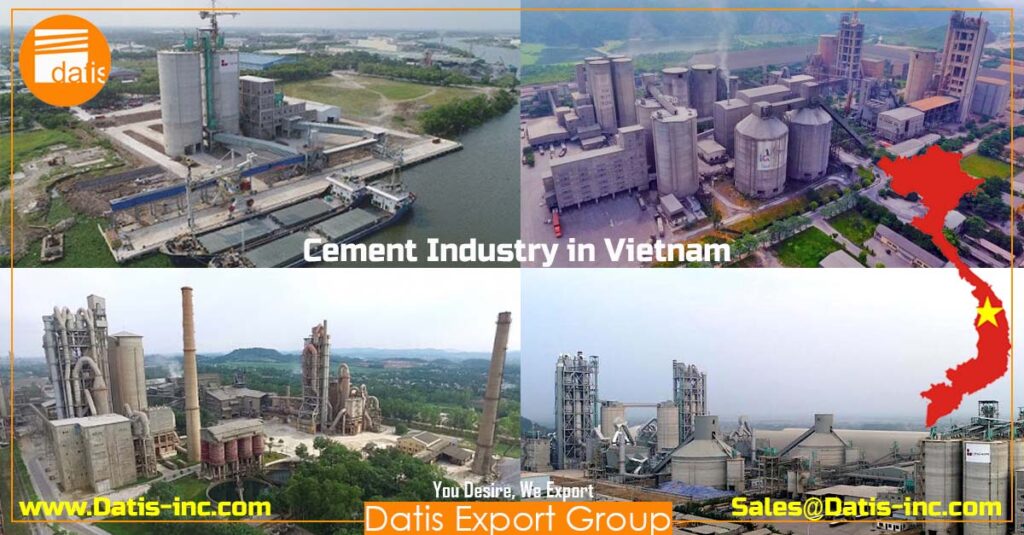
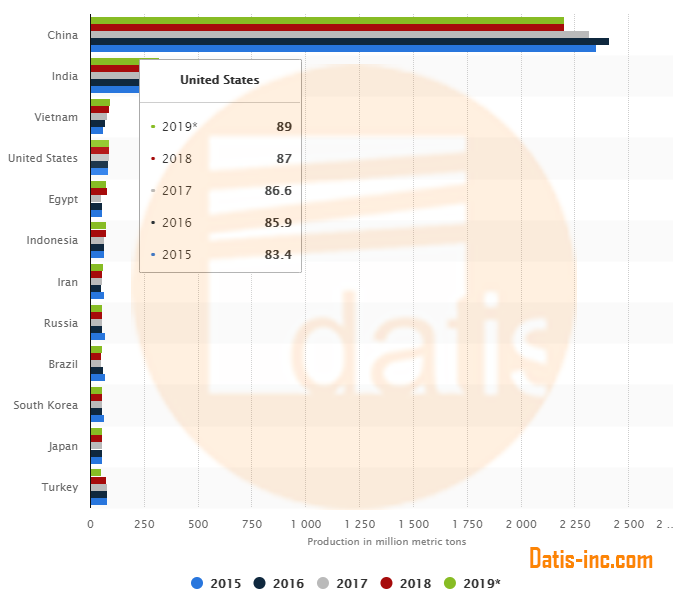
Vietnam Cement production
3rd Producer of the World
Vietnam is the third cement producer in the world after China and India.
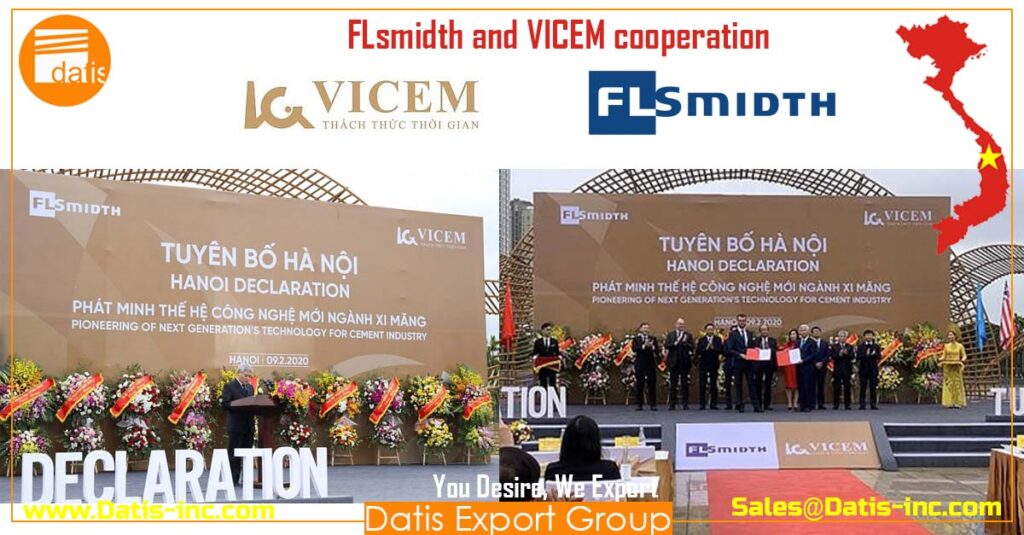
The future of the Cement business in Vietnam
The Export volume of cement is estimated to keep rising
Cement producers sold 45.7Mt of cement and clinker in the first half of 2020, down by 3% year-on-year from 47.1Mt in the first half of 2019. Exports grew by 1% to 15.6Mt from 15.4Mt. The Vietnamese National Cement Association (VNCA) says that producers retain a total of 0.8Mt of cement and 4.2Mt of clinker in inventory.
According to this market research, compared to China or other developed countries, low human resources cost is one of advantage of Vietnam cement industry. Besides, Vietnam possesses rich ore resources, which are raw materials of cement. The production cost of cement is mainly influenced by coal price.
Construction of infrastructure and booming property industry contributed to increasing domestic consumption of cement in Vietnam in recent years. Several large infrastructure projects are also underway. However, urbanization rate of Vietnam is still very low, only approximately 38% in 2018, which means the consumption of cement is not currently at the peak.
Although production and exports showed an upward trend, cement industry in Vietnam are still facing some challenges, including low efficiency and financial performance, such as average 16.9% EBITDA margin in 2018.
Cement designed capacity in Vietnam is expected to surge in the next three years for aggressive expansion of local manufacturers including Tan Thang, Vissai, and Xuan Thanh. In conclusion, Vietnam is expected to face with continuous supply surplus before reaching equilibrium. In other words, export volume of cement is estimated to keep rising in the future.
Two new cement plants in Vietnam will go into operation this year, according to Nguyen Quang Cung, president of the Vietnam Cement Association. The first is in Tan Thang commune, the central province of Nghe An, with a capacity of 2-2.5Mta, while a second new plant is being built in Bim Son commune, Thanh Hoa province, with a capacity of 4.6Mta.
Vietnam’s Ministry of Construction forecast that cement sales would increase by around five per cent to reach 103Mt in 2020, around 70Mt of which would be sold to the domestic market. The association also predicted a five per cent growth rate for the cement industry in 2020.
Regarding exports, Nguyen Quang Cung said that cement export volume would be around 34Mt this year, but fall to 25Mt in 2021 when domestic consumption is forecast to rise.
FOB Prices for Clinker, Grey Cement, and White Cement/ per MT
Cement Clinker
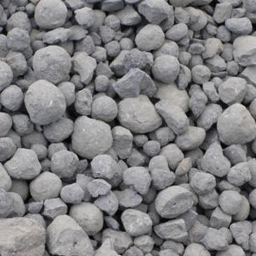
$19
Portland Cement Clinker-Type II
Status: Fresh, and High-Quality
Standard: ASTM C-150
Delivery: FOB-BIK Port
Payment Terms: TT
Grey Cement
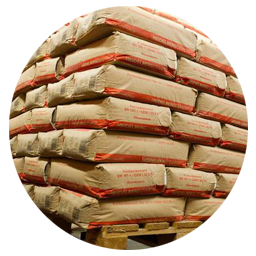
$36
Grey Cement-Type II
Status: Fresh, and High-Quality
Standard: ASTM C 150- Type II
Delivery: FOB-BIK Port
Payment Terms: TT
White Cement
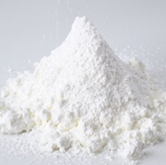
$61
Portland White Cement-52,5
Status: Fresh, and High-Quality
Standard: EN 197-1, 52,5
Delivery: FOB-BND Port
Payment Terms: TT
Gypsum
Rock
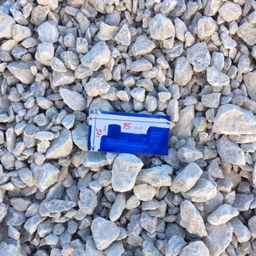
$8
GYPSUM rock
Status: High-Quality
Standard: Purity 90-95%
Delivery: FOB-BND Port
Payment Terms: TT
CIF offer
Letter of Intent-LOI in the first level
For CIF offer, our sales team should determine all details such as the product cost, transit to the port of loading, loading to the vessel (or stuffing), customs duties, etc.
we require to obtain accurate information on the inquiry as Letter of Intent-LOI in the first level. Please mail us LOI to our Sales Team.
We hope you find detailed information about the answer to the question of How many cement plants are producing in Vietnam 2020 in this article.
Datis Export Group supplies all types of Portland Cement (Grey, and White) and Cement Clinker. Our sales team will manage to export the Cement to any destination port for Bulk and Bagged containerized cargoes.
You can send us your cement inquiry by email to our sales office. Our branches will manage to supply and export the cement through the best-reputed cement factories in the region.

